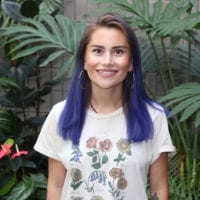
Characterizing the mechanism of cutin biosynthesis in tomato fruit
When plants evolved from water to terrestrial they developed a hydrophobic covering on the exterior of the epidermis known as the cuticle. The cuticle plays such a vital part to plants as it controls gas and water exchange with the environment, filters damaging UV light, limits the invasion of pathogens, aids in developmental and physiological process, and from an agricultural perspective, limits postharvest water loss and food wastage.
Despite the great importance of the polymerization of the monomers within, it is not very well known. If we had a greater understanding on the mechanisms of synthetization we could improve fruit quality and reduce food wastage. The Rose Lab discovered a Wildtype M82 mutant called cd1. The genome was mapped and it was discovered that a GDSL hydrolase that polymerized monomers was a mutation causing cd1 to have a 90-95% reduction in cutin. We know that the missing gene was the cutin synthase 1 gene, however, we do not know what is making the residual amount of cutin. If we could find out what is making the residual cutin we can have a deeper understanding of the mechanisms of polymerization and could improve the agricultural sector for many fruits. Due to cutin synthase 2’s closeness in phylogenetic lineage and given they are both in the same clade we hypothesized that the homolog of CUS1, CUTIN SYNTHASE2 (CUS2), is responsible for the synthesis of the residual cuticle in the cd1 mutant. To test this hypothesis, I characterized the cuticle morphology, biomechanical properties, and cutin synthase enzyme activity.
To measure the cuticle thickness, pieces of tomato pericarp will be cut from the different tomato genotypes at various fruit developmental stages, frozen in liquid nitrogen and embedded in Optimal Cutting Temperature (OCT) solution. The pieces will then be sectioned using a cryostat, attached to microscopy slides and stained with Oil Red O solution, which stains the cuticle. The slides will be viewed by light microscopy and photographed with a 0.5 mm scale bar. The cuticle thickness will be determined using ImageJ software and the data analyzed using Microsoft Excel. The biomechanical properties were tested using an Instron machine. A thin exterior layer of the tomato was sliced then put in a pectinase and cellulase solution where the cell walls were then digested. Once the cell walls were digested the cuticle was placed on the machine where its extensibility was then tested and characterized. To test the cutin synthase enzyme activity CUS1 and CUS2 were transiently expressed in tobacco. I used agrobacterium as a natural genetic engineer. I then introduced the gene of interest to the agrobacteria and injected it into the tobacco leaves. This induced expression in the leaves at which then the protein was isolated using a nickel column where the nickel would bind to the histag then unbind with imidazole thus giving me the pure protein. This protein was then characterized via gel electrophoresis and western blot both successfully revealing the protein putting us a step closer to solving the mystery of synthetization.
My Experience
This summer has been one of the most intense summers academically speaking. I had no Idea you could cram so much into 10 weeks but it is possible with hard work and determination. I was able to not only learn from the best of the best but truly connect on a personal level. From a science perspective I learned so much and created countless experiments but what I will take home from this is my passion to find out why and my curiosity to learn more. My mentor, PI, and other people in the lab were so nice that I just fell in love with the environment. It is so inspiring to go into work everyday not only to do exciting experiments but to be with people you look up to and connect with. This internship taught me how to work hard, it taught me what it is like to be a scientist in the lab, and it taught me personal confidence and while I might doubt myself or new things might be scary, I realize I can do them. This internship has opened and will continue to open many new doors even beyond the academic world.
